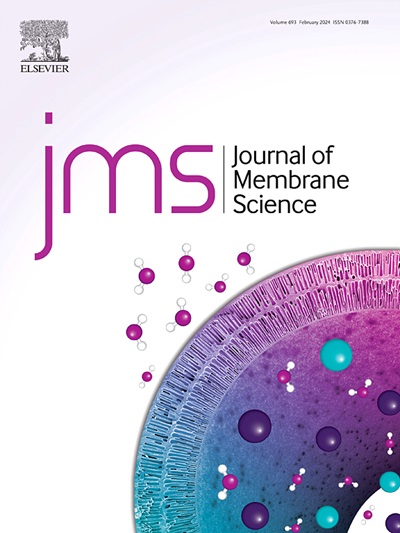调节生物过滤和捕食触发重力驱动膜系统:生物膜转化和膜效率
IF 8.4
1区 工程技术
Q1 ENGINEERING, CHEMICAL
引用次数: 0
摘要
重力驱动膜(GDM)系统通过形成生物膜来维持稳定的通量,从而提供分散式水处理。本研究通过PES、PES@TT、PES/PAC和联合PES/PAC@TT四组,系统地研究了生物过滤(粉末活性炭、PAC)和捕食(oligochaete T. Tubifex)在GDM系统中的单独和联合效应,为生物膜系统优化提供了新的见解。与原始PES组相比(UV254: 3.87%;TOC: 32.37%),单独使用T. Tubifex可使稳定通量提高20.35%,提高去除效果(UV254: 33.04%;TOC: 42.26%),首次证明了其作为GDM系统生物工具的可行性。其独特的“向上移动”行为(尾部向上,头部向下)通过生物灌溉和生物扰动增强了生物膜孔隙度和真核生物捕食,有效地平衡了通量稳定性和水质。同样,单独PAC预沉积可使通量提高45.93%,达到较好的污染物去除效果(UV254: 89.94%;TOC: 60.86%)通过培养微生物富集和生物膜异质性。通过预先沉积PAC以建立成熟的生物污染层,随后引入T. Tubifex,我们证明了顺序应用保持了较高的污染物去除率(UV254: 84.13%;TOC: 50.16%)。然而,PAC的物理存在限制了捕食者的运动和捕食,导致后期死亡和生物膜致密化,使稳定通量减少了10%。研究结果表明,吸附剂和外来捕食者可以调节生物污垢层的组成和结构,提高通量和水处理效率。通过将生物过滤和捕食与生物膜动力学联系起来,优化捕食者-吸收剂配对和操作顺序,以利用生态协同效应,为可扩展的水处理解决方案提供可操作的见解。本文章由计算机程序翻译,如有差异,请以英文原文为准。

Regulating biofiltration and predation to trigger gravity-driven membrane System: Biofilm transformation and membrane efficiency
The gravity-driven membrane (GDM) system provides decentralized water treatment by utilizing the formation of a biofilm to sustain stable flux. Our study systematically investigated the individual and combined effects of biofiltration (powdered activated carbon, PAC) and predation (oligochaete T. Tubifex) in GDM systems through four groups: PES, PES@TT, PES/PAC and combined PES/PAC@TT, revealing novel insights into biofilm system optimization. Compared with the pristine PES group (UV254: 3.87%; TOC: 32.37%), T. Tubifex alone increased stable flux by 20.35% and improved removal efficacy (UV254: 33.04%; TOC: 42.26%), marking the first demonstration of its viability as a bio-tool in GDM systems. Its unique “upward mover” behavior (tail-up, head-down) enhanced biofilm porosity and eukaryotic predation through bio-irrigation and bioturbation, effectively balancing flux stability with water quality. Similarly, PAC pre-deposition alone enhanced flux by 45.93% and achieved superior pollutant removal (UV254: 89.94%; TOC: 60.86%) by fostering microbial enrichment and biofilm heterogeneity. By pre-depositing PAC to establish a mature biofouling layer and subsequently introducing T. Tubifex, we demonstrated that sequential application maintained high pollutant removal (UV254: 84.13%; TOC: 50.16%). However, the physical presence of the PAC restricted predator movement and predation, causing late-stage mortality and biofilm densification, which reduced stable flux by 10%. Our findings demonstrate that adsorbents and non-native predators can regulate biofouling layer composition and structure, enhancing both flux and water treatment efficiency. By linking biofiltration and predation to biofilm dynamics, optimization of predator-absorber pairing and operational sequence to take advantage of ecological synergies, offers actionable insights for scalable water treatment solutions.
求助全文
通过发布文献求助,成功后即可免费获取论文全文。
去求助
来源期刊

Journal of Membrane Science
工程技术-高分子科学
CiteScore
17.10
自引率
17.90%
发文量
1031
审稿时长
2.5 months
期刊介绍:
The Journal of Membrane Science is a publication that focuses on membrane systems and is aimed at academic and industrial chemists, chemical engineers, materials scientists, and membranologists. It publishes original research and reviews on various aspects of membrane transport, membrane formation/structure, fouling, module/process design, and processes/applications. The journal primarily focuses on the structure, function, and performance of non-biological membranes but also includes papers that relate to biological membranes. The Journal of Membrane Science publishes Full Text Papers, State-of-the-Art Reviews, Letters to the Editor, and Perspectives.
 求助内容:
求助内容: 应助结果提醒方式:
应助结果提醒方式:


